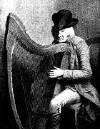

|

After being made (according to its inscription) in 1702, in Ballinascreen, (modern Draperstown), Co. Derry, the harp was bought for 18-year-old Denis O'Hampsey (1695-1807) (this would be in 1713 if we accept his claimed year of birth) by his first patron, Counsellor Canning, in Garvagh, Co. Derry, along with two other gentlemen, Gage and Bacon.
Denis O'Hampsey apparently played this harp for the whole of his life after that. He travelled widely in Ireland and Scotland, including a visit to Holyrood House in Edinburgh in 1745 when he played in front of Charles Stuart. In 1792 he was at the Belfast harpers' meeting, where, as the only person there to adhere to the old playing style with long fingernails, and with a very old and conservative repertory, he caught the interest of Edward Bunting. Bunting noted down many tunes from O'Hampsey's playing; amazingly, the manuscripts survive and as well as providing the raw material for 19th century Irish music collections, are the basis of today's revival of the historical Gaelic harp.
The portrait was made when O'Hampsey was very old; it shows the harp without its distinctive eel head. As the overhanging neck is a "trompe l'oeil" effect - the harp has the usual High Headed construction where the forepillar continues to the top of the bass - the neck of the eel is on the short grain and could easily have broken. Presumably it was kept in the back of the soundbox, or O'Hampsey's coat pocket, and re-attached after his death when the harp was taken to the Downhill house, the home of his patron, Hervey-Bruce.
The harp was preserved at Downhill for some years. It was eventually bought by the Guinness company to display in their museum, even though it has never been used in their publicity - they always use a drawing of the Trinity College harp. Presumably they just wanted an early Irish harp to display and this one came on to the market at the right time?
The harp has been displayed by Guinness ever since, and is now in their Storehouse Museum in Dublin.